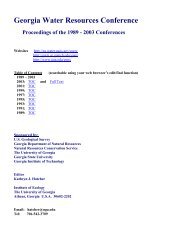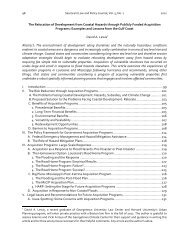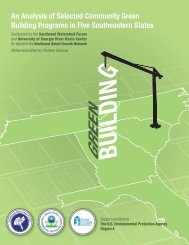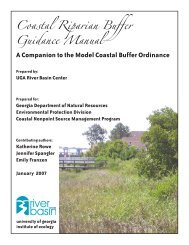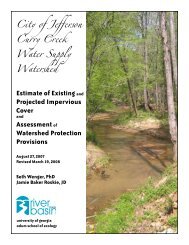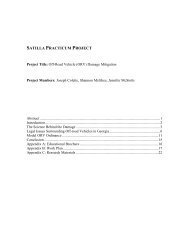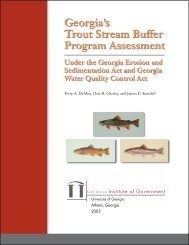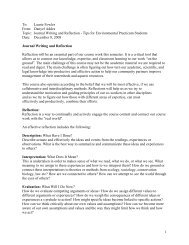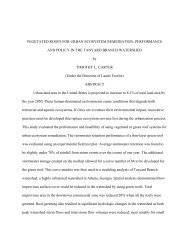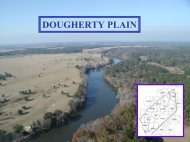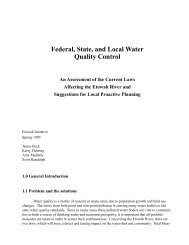1 Bibliographic Review of Sources Relevant to Development of Draft ...
1 Bibliographic Review of Sources Relevant to Development of Draft ...
1 Bibliographic Review of Sources Relevant to Development of Draft ...
You also want an ePaper? Increase the reach of your titles
YUMPU automatically turns print PDFs into web optimized ePapers that Google loves.
Savannah River Annotated Bibliography: January 2003<br />
seemed <strong>to</strong> be sufficient <strong>to</strong> allow the development and release <strong>of</strong> striped bass oocytes<br />
in<strong>to</strong> the Savannah River Estuary.<br />
Will, T.A., T.R. Reinert, and C.A. Jennings. 2002. Maturation and fecundity <strong>of</strong> a s<strong>to</strong>ckenhanced<br />
population <strong>of</strong> striped bass in the Savannah River Estuary, U.S.A. Journal<br />
<strong>of</strong> Fish Biology. 60, 532-544.<br />
A recent study on striped bass Morone saxatilis in the Savannah River Estuary<br />
indicate that maturation appears <strong>to</strong> be progressing normally and spawning is<br />
occurring. Cues necessary for oocyte development and release are present. Study<br />
suggests a time lag <strong>of</strong> 8-10 years for post-s<strong>to</strong>cking recovery (Will et al., 2002).<br />
Winger, P.V., and P.J. Lasier. 1994. Effects <strong>of</strong> salinity on striped bass eggs and larvae<br />
from the Savannah River, Georgia. Transactions <strong>of</strong> the American Fisheries Society.<br />
123, 904-912.<br />
The effects <strong>of</strong> varying salinities on stripped bass eggs and larvae was studied. Egg<br />
mortality occurs in salinities greater than 18%. Survival and length <strong>of</strong> larvae is<br />
reduced in 15% salinity. The 10 day LC50 for 2 day old post hatch larvae was 10%.<br />
Salinities over 9% are judged <strong>to</strong> be critical <strong>to</strong> S. R. striped bass eggs and larvae.<br />
Robust Redhorse<br />
Dilts, W.D. 1999. Effects <strong>of</strong> fine sediment and gravel quality on survival <strong>to</strong> emergence <strong>of</strong><br />
larval robust redhorse Moxos<strong>to</strong>ma robustum. Masters Thesis. The University <strong>of</strong><br />
Georgia.<br />
Survival <strong>to</strong> emergence (STE) <strong>of</strong> robust redhorse was inversely related <strong>to</strong> percent fine<br />
sediment in labora<strong>to</strong>ry studies. Treatments containing 50% probably depressed dissolved<br />
oxygen. Because sedimentation is related <strong>to</strong> flow, both should be considered in flow<br />
recommendations for the robust redhorse.<br />
ENTRIX, Inc. 2002a. Protected Species Resource Report for the Augusta Canal<br />
Hydropower Project-Appendix A. Special concern animals list from GADNR. FERC<br />
No. 11810<br />
Freeman, B.J. and M.C. Freeman. 2001. Criteria for Suitable Spawning Habitat for the<br />
Robust Redhorse Moxos<strong>to</strong>ma robustum. A Report <strong>to</strong> the U.S. Fish and Wildlife<br />
Service, January 2001.<br />
Robust redhorse data were collected over several years in the Savannah River <strong>to</strong><br />
determine habitat suitability criteria. Criteria for spawning habitat are water depth <strong>of</strong><br />
.29-1.1m, velocity <strong>of</strong> .26-.67 m/s, and substrate <strong>of</strong> coarse gravel.<br />
Ruetz, C.R. III., and C.A. Jennings. 2000. Swimming performance <strong>of</strong> larval robust<br />
redhorse Moxos<strong>to</strong>ma robustum and low-velocity habitat modeling in the Oconee<br />
River, Georgia. Transactions <strong>of</strong> the American Fisheries Society. 129, 398-407.<br />
Larval robust redhorse Moxos<strong>to</strong>ma robustum were tested <strong>to</strong> see if they could <strong>to</strong>lerate<br />
water velocities commonly found during hydropower generation in the Oconee<br />
River. They concluded that low-velocity habitats were available in the Oconee<br />
River, but they were dynamic during fluctuating discharge. The ability <strong>of</strong> these fish<br />
<strong>to</strong> access these areas, either through lateral or downstream movement, is unknown<br />
48



